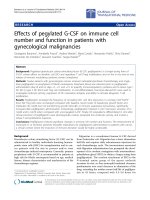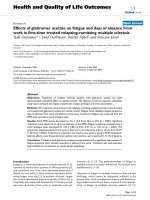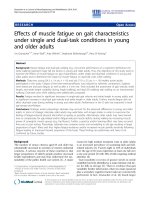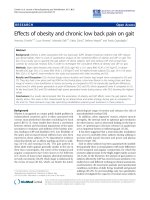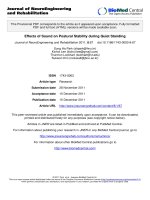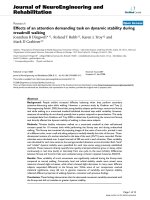báo cáo hóa học: " Effects of furosemide on the hearing loss induced by impulse noise" potx
Bạn đang xem bản rút gọn của tài liệu. Xem và tải ngay bản đầy đủ của tài liệu tại đây (237.7 KB, 7 trang )
RESEARCH Open Access
Effects of furosemide on the hearing loss
induced by impulse noise
Cahtia Adelman
1,3
, Jeffrey M Weinberger
2
, Leonid Kriksunov
3
and Haim Sohmer
4*
Abstract
Background: The permanent hearing loss following exposure to intense noise can be due either to mechanical
structural damage (tearing) caused directly by the noise or to metabolic (biochemical) damage resulting from the
elevated levels of free radicals released during transduction of the sound overstimulation. Drugs which depress
active cochlear mechanics (e.g. furosemide and salicylic acid) or anti-oxidants (which counteract the free radicals)
are effe ctive in reducing the threshold shift (TS) following broadband continuous noise. This study was designed to
determine whether furosemide can reduce the TS following exposure to impulse noise, similar to its action with
continuous broadband noise.
Methods: Shortly after furosemide injection, mice were exposed to simul ated M16 rifle impulse noise produced by
different loudspeakers and amplifiers in different exposure settings and, in other experiments, also to actual M16
rifle shots.
Results: Depending on the paradigm, the simulated noises either did not produce a TS, or the TS was reduced by
furosemide. The drug was not effective in reducing TS resulting from actual impulse noise.
Conclusion: Simulated M16 rifle impulse noise may not truly replicate the rapid rise time and very high intensity of
actual rifle shots so that the TS following exposure to such noise can be reduced by these drugs. On the other
hand, actual M16 impulse noise probably causes direct (frank) mechanical damage, which is not reduced by these
drugs.
Keywords: impulse noise noise induced hearing loss, protection, cochlear amplifier, outer hair cell motility, active
mechanical displacements, free radicals, furosemide
Background
Noise induced hearing loss (NIHL) affects many people
in the world. The source of the noise can be industrial,
recreational or military [1]. Therefore attempts have
been made to prevent and alleviate the resulting impair-
ment. These attempts include educational efforts [2],
use of mechanical ear protecting devices [ 3] and phar-
maceutical agents [4,5]. The types of noise can be
broadly divided into two categories: continuous noise
such as from personal music p layers, and impulse noise,
for example that resulting from firearms. Much research
has focused on the possible administration of drugs
which could prevent the damage resulting from the
exposure to continuous noise. Such research, besides
suggesting drugs whic h could alleviate the NIHL, also
provides insight into the possible mechanism of the
NIHL caused by expo sure to continuous noise. For
example, it has been shown that if one administers, just
before (but not after) a continuous noise exposure,
drugs which reversibly reduce the magnitude of the
active mechanical displacements produced in the
cochlea in response to sound (temporarily depressing
the cochlear amplifier, with reduced outer hair cell
motility and decreased active basilar membrane displa-
cement), the resulting permanent threshold shift (PTS)
is significantly smaller than that in animals given saline
(mean PTS was 15 dB smaller with salicylic acid [6];
mean PTS wa s 12 dB smaller with furosemide [7]). T his
result, together with the finding that several anti-oxidant
drugs administered before and after a continuous noise
* Correspondence:
4
Dept. of Physiology; Institute for Medical Research - Israel-Canada; Hebrew
University-Hadassah Medical School, POB 12272, Jerusalem 91120, Israel
Full list of author information is available at the end of the article
Adelman et al. Journal of Occupational Medicine and Toxicology 2011, 6:14
/>© 2011 Adelman et al; lic ensee BioMed Central Ltd. This is an Open Access article distributed under the terms of the Creative
Commons Attribution License ( which permits unrestricte d use, distribution , and
reproduction in any medium, provided the ori ginal work is properly cited.
exposure (for example, salicylate and trolox [4,5,8]) are
also effective in protecting the ear, provides evidence that
the hearing loss following exposure to continuous noise is
due to the generation of elevated levels of reactive oxygen
and nitrogen species (ROS and RNS), free radicals, which
then cause metabolically (biochemical) originating damage
to vital structures in the cochlea [9]. The production of
elevated levels of ROS is due to the higher metabolic
demand needed to maintain the cochlear electrical-chemi-
cal gradients required for transduction during the noise
exposure. The elevated ROS levels are a direct result of
the higher metabolic demand. Therefore, in the presence
of drugs which reversibly depress the active mechanical
displacements, there is reduced metabolic demand, produ-
cing lower levels of ROS, and in this case of reduced levels
of ROS, the administration (in addition to the furosemide)
of anti-oxidant drugs which counteract the ROS does not
provide further protection [10].
On the other hand, the mechanism of NIHL following
exposure to impulse noise is likely more complicated since
impulse noise is intermittent, it reaches very high sound
pressures with a very rapid rise time [11] and is of short
duration. Therefore the NIHL seen followi ng impulse
noise can be the product of direct (frank) mechanical dis-
ruption of tissues (tearing) and/or indirect metabolically
originating tissue damage resulting from production of
elevated levels of ROS [12], as seems to be the case with
continuous noise. In this study, we attempted to gain
insight into the possible mechanism(s) of the NIHL fol-
lowing exposure to impulse noise by administering one of
the drugs (furosemide) whi ch reversibly depresses the
cochlear amplifier and has been found [7] to provide pro-
tection from continuous broadband noise. The drug was
administered in a single injection just before the exposure
to the impulse noise, similar to the timing of injections
found to p rovide protection from con tinuous broadband
noise. The type of impulse noise chosen for study was the
M16rifleinusebythearmedforcesofmanycountries.
The first stage of the study involved attempts to adapt the
M16 impulse noise exposure to laboratory conditions by
making use of a simulated M16 impulse electrical wave-
form obtained from a sound effects site on the Internet.
This electrical waveform was applied to various types of
amplifiers, loud speakers and exposure conditions in order
to deliver the simulated M16 rifle shots to mice under
laboratory conditions. The results of this phase of the
experiment led us to the second stage in which mice were
exposed to actual M16 r ifle shots during target practice
sessions in an open firing range.
Methods
General outline of experimental paradigm
The experiments were conducted on seven-week-old
albino male mice (body weight 35-45 grams) of the
normal Sabra strain obtained from Harlan, Israel. Auditory
thresholds before and after the exposure to the impulse
noise were assessed by recording the auditory nerve brain-
stem evoked response (ABR) thresholds to broadband
clicks (which deliver a wide range of frequencies) and
8000 Hz tone bursts (TB) under anesthesia. These stimuli
were chosen in order to enable uniformity and comparison
with the experiments conducted in this laboratory with
continuous noise exposure and furosemide [7 ,10]. The
ABR thresholds in these mice were similar to those in fat
sand rats (Psammomys obesus) and to the behavioral
thresholds of normal hearing humans to the same broad-
band click s delivered by the same insert earphones. Only
animals with ABR thresholds to broadband clicks of 65 dB
peak equivalent (pe) SPL or better were used in the study.
There was no change in threshold over the time duration
(one week) of this experiment (i.e. contro l for aging) [6].
The next day, when anesthesia had worn off, a single injec-
tion of 100 mg/kg of furosemide was administered intra-
periteoneally (IP) to the mice of the experimental group
and the mice of the control group were injected (IP) at the
same time with a similar volume of saline. All mice,
experimental (furosemide) and control (saline) together,
were exposed to M16 impulse noise (either simulated in
the laboratory, or actual) one hour after the injections, at
the time of maximal cochlear amplifier depression, as indi-
cated by elevated hearing thresholds following furosemide
injection in earlier experiments [7]. ABR thresholds to
click and to 8000 Hz tone bursts were recorded again after
a week and compared to the initial thresholds, to deter-
mine resulting threshold shifts (TS). Initial thresholds in
both the control and the experimental groups were com-
pared. As no significant difference was found between
these initial t hresholds (two-tailed t-tests), the statistical
evaluation (again using two-tailed t-tests) was then con-
ducted on the thresho lds determined a week after the
noise exposure
Anesthesia
The ABR thresholds to clicks and to 8000 Hz tone bursts
were determined in mice anesthetized with Avertine
11.25 mg/kg injected intraperitoneally (IP). Additional
anesthesia was administered if necessary to maintain
areflexia.
Auditory Brainstem Response (ABR)
Stimuli were presented to the left ear through an insert
earphone, and ABR was recorded between subdermal
needle electrodes at vertex and chin, with a ground elec-
trode in the left hindlimb, using a Biologic Navigator
Pro evoked potential system (Bio-logic Systems Corp.,
Mundelein, Il., USA). Thresholds were recorded to two
types of stimuli: alternating polarity broadband clicks
and alternating polarity 8000 Hz tone bursts (Blackman
Adelman et al. Journal of Occupational Medicine and Toxicology 2011, 6:14
/>Page 2 of 7
ramp, with a rise/fall time of 0.5 msec and a plateau of
5 msec). The stimuli were presented from a maximal
intensity of 120 dB pe SPL and decreased to below
threshold in 5 dB steps. The responses were filtered
(band pass 300-3000 Hz), amplified, and 128-256
responses were averaged. The lowest stimulus intensity
at which repeatable components of ABR (usually the
first wave - the compound action potential of the audi-
tory nerve) were obtained in at least two recordings was
defined as threshold.
All of the experiments were evaluated and approved
by the Hebrew University - Hadassah Medical School
Animal Care and Use Committee.
Simulated M16 rifle impulse noise
The electrical waveform of the M16 firing was obtained
from a sound effects Internet site [13]. Preliminary
experim ents were conducted in order to assess the opti-
mal combination of amplifiers, loud speakers, number of
firings (each click of the mouse of the computer pro-
vided a single firing), their s ound intensity and the
mode of their delivery to the experimental animals
which would provide a TS when recording a week later.
The desired TS was one which could be measured, yet
was not too great for possible reduction (prot ection) by
the drug administered (to avoid a “ceiling effect”).
Initial experimental presentations of simulated M16 noise
which did not produce a TS a week later
Experim ent I-Methods and Results These experiments
included presenting the simulated M16 noise by stan-
dard computer speakers placed on top of the cage of the
animals. The peak intensity of each M16 firing which
was measured with a Bruel & Kjaer precision integrating
sound level meter (type 2218) was 123 dB SPL, but did
not produce a TS when recording a week later. An addi-
tional preliminary experiment involved a power ampli-
fier (50W Yamaha EM120 power amplifier) with a very
large (89.5 cm high; 47 cm wide; 43.5 cm depth) loud
speaker (Electro-Voice ECS 15-3 300 W speaker-40 cm
diameter of diaphragm), providing a peak sound level of
about 155 dB SPL. Nevertheless, 700 firings of such a
simulated M16 rifle did not produce a TS in recordings
a week later in two fat sand rats (Psammomy obesus)
and this noise exposure paradigm was not applied
further.
Experiments with simulated M16 exposure which produced
a TS a week later
Experiment II-Methods More powerful computer
speakers (a pair of 20W computer speakers; Yamaha
powered speaker model DM-01) produced 135 dB SPL
peak noise. Eleven mice were injected with furosemide
and a control group of 8 mice were injected with a simi-
lar volume of saline a nd then all 19 mice, awake, were
exposed together, an hour later, to the 135 dB SPL
simula ted M16 impulse noise. The speakers were placed
onthetopofthecage,and120firingswerepresented,
dispersed randomly over a period of six minutes.
Experiment II-Results Because t-tests showed that
there was no si gnificant difference between the initial
thresholds in the saline group (mean thresholds: to
broadbandclicks57.5±7.1dBpeSPL,to8000HzTB
58.1 ± 10.0 dB pe SPL) and the group which would be
receiving furosemide (mean thresholds: to click 58.2 ±
6.4 dB pe SPL, to 8000 Hz TB 62.7 ± 12.1 dB pe SPL)
before the exposure to n oise, the statistical evaluations
and comparisons were conducted on the thresholds
determined a week after the simulated M16 noi se expo-
sure. The thresholds to clicks and to 8000 Hz tone
bursts in the saline control group were significantly ele-
vated a week later by the simulated noise exposure (to
click 69.4 ± 15.5 dB pe SPL; P < 0.05, to 8000 Hz T B
73.1 ± 13.4 dB pe SPL; P < 0.005 ; one-tailed t-tests), i.e.
the simulated noise caused a significant threshold shift
in the control group (a mean TS of 11.9 dB [± 18.3] in
response to clicks and 15.0 dB [± 11.7] with 8000 Hz
tone bursts). On the other hand, in the furosemide
group, the threshold (to click 56.4 ± 6.0 dB pe SPL, to
8000 Hz T B 58.6 ± 9.5 dB pe SPL) was not significantly
different from the initial threshold (i.e . there was no TS
in this furosemide group, meaning total protectio n).
Thus in this experiment with the more powerful com-
puter speakers which produced a TS of 12-15 dB in
mice, the furosemide provided protection from the
simulated M16 impulse noise.
Experiment III-Methods Exposure to simulated M16
impulse noise in a specially construc ted exposure cham-
ber. In order to enhance the acoustic energy reaching
the mice, and to prevent dispersion of the impulse noise
to a large sound field, a small volume exposure box was
designed (dimensions 31 cm length; 20 cm width; 32 cm
depth). The simulated M16 was amplified by a NAD
C300 stereo integrate d amplifier. The speaker (Focal JM
Lab Chorus 705V) fit snugly in the upper part of t he box
and the animal enclosure in the lower section. The dia-
phragm of the speaker was 16 cm above the floor of the
mice enclosure, so that the net volume of the exposure
chamber was 9920 cm
3
.Miceinonegroup(n=10)
received a single of injection of furosemide one hour
before exposure to 10 computer simulated M16 shots,
estimated (with sound level meter) at 155 dB peak SPL.
Mice of the other group (control, n = 10) were injected
with a similar volume of saline at the same time, and
exposed to the sa me noise together with the furo semid e
group.
Experiment III - Results Mean initial broadband click
ABR threshold was 59.0 ± 6.15 dB pe SPL in the saline
group and 60.5 ± 5.5 dB pe SPL in the group which
would be receiving furosemide (two-tailed t-test, no
Adelman et al. Journal of Occupational Medicine and Toxicology 2011, 6:14
/>Page 3 of 7
significant difference, p = 0.57). Mean initial ABR
threshold to 8000 Hz tone burst was 64.5 ± 14.6 dB pe
SPL in t he saline group and 62.0 ± 14.8 dB pe SPL in
the furosemide group (two-tailed t-test, no significant
difference, p = 0.71).
Mean click ABR threshold one week after exposure to
thesimulatedM16noisewas81.5±18.4dBpeSPLin
the saline group and 62.5 ± 7.9 dB pe SPL in the furose-
mide group. Comparison of click thresholds before and
after exposure to noise in the saline group showed a sig-
nificant threshold shift (2-tailed, paired t-test, p < 0.005).
Thresholds before and after exposure to noise were not
significantly different in the group injected with furose-
mide (2-tailed, paired t-test,p=0.22);i.e.total
protection.
Mean 8000 Hz TB A BR threshold one wee k after
exposure to noise was 81.0 ± 18.7 dB pe SPL in the sal-
ine group and 63.0 ± 14.6 dB pe SPL in the furosemide
group. Comparison of TB thresholds before and after
exposure to noise in the saline group showed a signifi-
cant threshold shift (2-tailed, paired t-test, p < 0.05); i.e.
noise exposure induced a significant threshold shift.
There was no significant difference between thresholds
before and one week after exposure to noise in the furo-
semide group (2-tailed, paired t-test, p = 0.8); i.e. total
protection.
Comparison of the two groups (saline vs furosemide)
revealed a significant difference between thresholds to
click (two-tailed t-test, p < 0.05) and to tone bursts
(two-tailed t-test, p < 0.05) one week after e xposure to
noise. Thus in this preliminary experiment w ith simu-
lated M16 impulse noise in a specially constructed expo-
sure chamber, furosemide was effective in protecting the
mice. Based on these findings, the next stage of the
study involved complementing the simulated M16
experiments with exposure of mice to actual M16 rifle
shots during a target practice se ssion in an outdoor rifle
firing range.
Actual M16 rifle impulse noise (outdoor firing range)
Experiment IV - Methods Mice in one group (n = 8)
received a single injection of furosem ide one hour before
exposure to 10 M16 shots at a distance of 5 meters, esti-
mated with sound level meter at approximately 155 dB
peak SPL. Mice of the other group (control, n = 8) were
injected with a similar volume of saline at the same time,
and exposed to the same noise together with the furose-
mide group.
Experiment IV - R esults Mean initial click ABR thresh-
old was 56.9 ± 7.0 dB pe SPL in the saline group and 56.3
± 6.4 dB pe SPL i n the group which would be receiving
furosemide (two-tailed t-test, no significant difference, p =
0.86). Mean initial ABR threshold to 8000 Hz tone burst
was 59.38 ± 7.76 dB pe SPL in the saline group and 55.6 ±
4.2 dB pe SPL in the furosemide group (two-tailed t-test,
no significant difference, p = 0.25).
Mean broadband click ABR threshold one week after
exposure to noise was 70.6 ± 12.7 dB pe SPL in the saline
group and 72.5 ± 6.6 dB pe SPL in the furosemide group.
Comparison of click thresholds before and after exposur e
to noise in the saline group showed a significant thresh-
old shift (1-tailed, paired t-test, p < 0.05). A significant
(1-tailed, paired t-test, p < 0.005) threshold shift was also
found in the group injected with furosemide.
Mean 8000 Hz TB A BR threshold one wee k after
exposure to noise was 73.1 ± 13.9 dB pe SPL in the sal-
ine group and 80.6 ± 14.5 dB pe SPL in the furosemide
group. Comparison of TB thresholds before and after
exposure to noise in the saline group also showed a sig-
nificant threshold shift (1-tailed, paired t-test, p < 0.05),
and a significant (1-tailed, paired t-test, p < 0.005)
threshold shift was found in the furosemide group as
well. Thus exposure to actual M16 firing produced a
threshold shift both in the furosemide and in the saline
control groups.
Comparison of the two groups (furosemide to saline)
showed that t here was no significant difference between
thresholds to click or to tone bursts one week after
exposure to noise (two-tailed t-tests). Mean threshold
shift to broadband clicks was 13.8 ± 15.5 dB in the sa l-
ine group and 16.3 ± 9.9 dB in th e furosemide group,
with no significant difference between them (two-tailed,
p = 0.7). Mean threshold shift to TB was 13.8 ± 19.6 dB
in the saline group and 25.0 ± 15.1 dB in the furosemide
group, again with no significant difference between them
(two-tailed, p = 0.2).
The results of these experiments (group, intensity and
rise time of the impulse noise, the degree of the thresh-
old shift and possible protection by furosemide) have
been summarized in Table 1.
Discussion
Because furosemide, in a single injection just before
exposure to continuous broadband noise, leads to a
smaller NIHL i.e. protection, this study was designed to
determine whether such would be the case with impulse
noise. Impulse no ise is defined as “ a short duration
sound that is characterized by a shock wave having
nearly instantaneous rise time” [14]. In the present
report, the impulse noise chosen for study was that of
the firing of an M16 rifle. Because exposing animals to
actual M16 firings is not practical in the laboratory, we
began with simulated M16, obtaining the electrical
waveform from a sound effects site and transducing it
with several different types o f amplifiers, speakers and
exposure settings. Others [15-19] have also used compu-
ter simulations for impulse noise, for the same practical
Adelman et al. Journal of Occupational Medicine and Toxicology 2011, 6:14
/>Page 4 of 7
reasons. In the present study,theabilityoffurosemide
to protect from exposure to actual M16 firing was also
assessed. It is difficult to measure impulse noise (which
is characterized by extremely high levels, rapid rise
times and short durations) accurately using conventional
sound level meters (which are designed to functio n only
up to about 140 dB SPL), a nd there are as yet no stan-
dards or norms for measurement [11,20,21]. Therefore,
in the present study, the peak levels of the impulse
noise had to be estimated. Using specially designed
equipment, it has been shown [11] that the impulse
noise from actual firing of an M16 rifle reaches a peak
level of 165 dB SPL w ith a rise time of 88 μsec. In the
present study, initial experiments showed that simulated
M16 is not always effective in producing a threshold
shift. In further experiments with different exposure
procedures (amplifiers and speakers), the simulated M16
did produce a threshold shift in measurements a week
after the exposure to noise, and furosemide was effective
in reducing this threshold shift, similar to the prote ction
it provides with continuous broadband noise. However,
when the experiment was repeated using actual M16
shots in a firing range, the furosemide failed to provide
protection. This seems to be similar to the ineffective-
ness of the anti-oxidant NAC in reducing the perma-
nent threshold shift and hair cell loss in the ear of
chinchillas exposed to high kurtosis noise (i.e. a combi-
nation of high intensity impulse noise and continuous
noise) presented for a long duration (eight hours per
day for five days) [22], whereas it has been reported that
NAC can reduce the permanent threshold shift due to
continuous noise [18].
Thus there are discrepancies between the magnitudes
of the threshold shift in these different experiments,
even though the threshold shift was assessed in a uni-
form manner, i.e. in the same species, same drug, with
the same ABR evaluation. These apparent discrepancies
between simulated impul se noise which did not cause a
threshold shift, simulated impulse noise producing a
threshold shift which was reduced by furosemide and
actual impulse noise causing a threshold shift which was
not reduced by furosemide, require further thought.
Actual impulse noise is intermittent (and not continu-
ous as is b roadband noise); and even during these tran-
sient bursts of noise, the intensity is high at the onset of
each such burst and then rapidly d eclines. Each explo-
sive firing reaches a very high peak level with a very
rapid rise time. The rapid rise to high peak levels can
cause direct (frank) mechanical damage to inner ear
stru ctures [1] and it is no t likely that furosemide, which
provides protection when administered just befo re the
noise by reducing active OHC displacements, could pro-
vide protection from this component of the noise. In
addition, the high peak levels can also induce biochem-
ical (metabolic) damage resulting from the elevated
release of ROS accompanying the greater metabolic
demands of transduction during the high level noise
exposure. This component of the impulse noise thresh-
old shift can be effectively reduced by furosemide, as
during exposure to continuous broadband noise.
In those initial simulated impulse noise experiments in
which a threshold shift (assessed a week after exposure
to noise) was not induced, it is likely that the intensity
was not sufficiently high (smaller speakers), and/or that
the rise time was slower than that in actual M16 rifle
firings (since the simulation was lacking the explosive
firing component), and the total duration of the impulse
noise resulting from shots dispersed over some time
period was less than that from c ontinuous noise pre-
sented over the s ame time period. Thus it is likely that
the simulated impulse noise presented intermittently
(not continuously) did not produce excessive ROS levels,
Table 1 Summary of experimental groups, intensity and rise time of impulse noise, degree of threshold shift and
possible protection by furosemide
Noise
Intensity
(dB SPL)
Presumed
rise time
(μsec)
TS
(dB)
Furosemide
protection
Explanation
(see text for
details)
Simulated MI6; sound effects site
Experiment
Ia - Computer speaker (mice)
123 >88 NS NA Intensity too low
Ib - Power amplifier, very large speaker (Psammomys) 155 >>88 NS NA Rise time too slow
II - 20W speaker (mice) 135 >88 11.9 Total Active displacements reduced by furosemide
III - Small exposure chamber (mice) 155 >88 22.5 Total Active displacements reduced by furosemide
Actual M16; firing range
IV - Actual M16; firing range (mice) 155 88 13.7 None Tearing damage; furosemide not effective
NS - not significant.
NA - not applicable.
Adelman et al. Journal of Occupational Medicine and Toxicology 2011, 6:14
/>Page 5 of 7
and the intrinsic levels of anti-oxidants were able to
counteract them.
On the other hand, furosemide did provide protection
in one of t he simulated M16 experiments, where peak
intensity was 155 dB SPL. In this case, there is reason to
believe that the peak intensity and the rise time of the
small speaker used to produce the simulated M16
impulse did not accurately replicate those of an actual
M16 firing (88 μsec) due to the absence of an initial
supersonic shock wave, accompa nying the explosive
force of the firing, and that the small dimensions of the
exposure box caused reverberations (reflections) from
the surfaces of the box with various phases and with a
short latency which would degrade, smear and reduce
the rise time of the impulse reaching the ear [20,21]. In
such a situation, the simulated impulse noise would be
dominated by the high intensity noise component
(which can be reduced by the furosemide) and not by
the rapid rise time component (which was degraded).
Similarly, in a simulated noise experiment in which fat
sand rats were exposed to 700 shots fro m a very large
speaker (which did not produce a threshold s hift), the
very large diaphragm of the speaker was not able to “fol-
low” the rapid rise time of the electrical waveform so
that this too did not conform to the definition of
impulse noise, which includes rapid rise time.
Thus, when the intensity and the rapid rise time of the
impulse noise are compromised (degraded) by the
experimental conditions (e.g. a speaker that is unable to
replicate the intensity and rise time of an actual M16
firing, or reverberations causing degradation of the rapid
rise time), either there is no thr eshold shift or the
threshold shift, induced by the high intensity noise com-
ponent, can be reduced by furosemide. Other research
groups have also delivered sim ulated impulse noise by
means of a closed sound system through a narrow t ube
[17,23] i.e. a small, cone shaped horn placed in the ear
canal of animals, or very close to the ear [15,24] and it
has been reported that different drugs and agents (the
antioxidant NAC, Mg, conditioning ) provided protection
from the impulse no ise. The closed, narro w bore
impulse noise delivery system was used in order to con-
serve the impulse noise sound energy without dispersion
to a large volume. However it is likely that the small
horn also led to reverberations (reflections), with degra-
dation of the rapid rise time, so that t he antioxidants
could reduce NIHL from impulse no ise by ne utralizi ng
the resulting ROS. The possibility that some protection
against impulse noise which has all of the attributes of
actual impulse noise (reaching a very high intensity,
within a very short rise time) can be provided by these
drugs leads to the suggestion that such a noise also
induces ROS, and not only direct mechanical (frank)
damage (tearing), as has been suggested [1,12].
It has been shown that NAC can protect against simu-
lated impulse noise [17,18]. Therefore, consideration
should be given to further research with actual M16
impulse noise, in which the protection provided by anti-
oxidants would be determined, as in the present study
with furosemide , using a similar experimental paradigm.
The protective effect of antioxidants and furosemide
against continuo us broadband noise has been compared
[10].
Conclusions
In different experiments designed to assess drugs poten-
tially protecting from impulse noise, there may be differ-
ent proportions of the two possible injurious
components: rapid rise time, causing direct (frank)
mechanic al lesions which are not amenable to reduction
by furosemide, and high noise levels for shor t durations
(furosemide would be able to reduce the active mechan-
ical displacements, leading to lower levels of free radi-
cals ROS). When the rapid rise time is attenuated by
the experimental conditions (e.g. reverberations degrad-
ingit),thenoiseexposureisdominatedbythehigh
noise level component and furosemide (and other drugs
which counteract ROS such as anti-oxidants) can reduce
the NIHL. However, when the impulse noise is domi-
nated by a rapid rise time reaching a very high intensity
(as in actual M16 f iring), and the exposure duration is
much longer as in the high kurtosis study (eight hours
per day for five days) [22], it is likely that the dominant
factor producing the threshold shift is the rapid rise
time with direct (frank) mechanical tissue damage which
cannot be reduced by drugs such as furosemide.
Author details
1
Speech & Hearing Center, Hadassah University Medical Center, POB 12000,
Jerusalem 91120, Israel.
2
Dept. of Otolaryngology and Head & Neck Surgery,
Hadassah University Medical Center, POB 12000, Jerusalem 91120, Israel.
3
Dept. of Communication Disorders-Hadassah Academic College, POB 1114,
Jerusalem 91010, Israel.
4
Dept. of Physiology; Institute for Medical Research -
Israel-Canada; Hebrew University-Hadassah Medical School, POB 12272,
Jerusalem 91120, Israel.
Authors’ contributions
CA conducted the study and contributed to the writing. JMW contributed
to data collection. LK contributed to the interpretation of the results. HS
conceived of the study, participated in the design and drafted the
manuscript. All authors read and approved the final manuscript.
Competing interests
The authors declare that they have no competing interests.
Received: 6 September 2010 Accepted: 8 May 2011
Published: 8 May 2011
References
1. Clifford RE, Rogers RA: Impulse noise: theoretical solutions to the quandry
of cochlear protection. Ann Otol Rhinol Laryngol 2009, 118:417-427.
2. Folmer RL, Griest SE, Martin WH: Hearing conservation education
programs for children: a review. J Sch Health 2002, 72:51-7.
Adelman et al. Journal of Occupational Medicine and Toxicology 2011, 6:14
/>Page 6 of 7
3. Verbeek JH, Kateman E, Morata TC, Dreschler W, Sorgdrager B:
Interventions to prevent occupational noise induced hearing loss.
Cochrane Database Syst Rev 2009, 8:CD006396.
4. Kopke RD, Jackson RL, Coleman JK, Liu J, Bielefeld EC, Balough BJ: NAC for
noise: from the bench top to the clinic. Hear Res 2007, 226:114-125.
5. Le Prell CG, Hughes LF, Miller JM: Free radical scavengers vitamins A, C,
and E plus magnesium reduce noise trauma. Free Radic Biol Med 2007,
42:1454-1463.
6. Adelman C, Freeman S, Paz Z, Sohmer H: Salicylic acid injection before
noise exposure reduces permanent threshold shift. Audiol & Neurotol
2008, 13:266-272.
7. Adelman C, Perez R, Nazarian Y, Freeman S, Weinberger J, Sohmer H:
Furosemide before noise exposure can protect the ear. Ann Otol Rhinol
Laryngol 2010, 119:342-349.
8. Yamashita D, Jiang HY, Le Prell CG, Schacht J, Miller JM: Post-exposure
treatment attenuates noise-induced hearing loss. Neuroscience 2005,
134:633-642.
9. Henderson D, Bielefeld EC, Harris KC, Hu BH: The role of oxidative stress in
noise-induced hearing loss. Ear & Hearing 2006, 27:1-19.
10. Tamir S, Adelman C, Weinberger JM, Sohmer H: Uniform comparison of
several drugs which provide protection from noise induced hearing loss.
Journal of Occupational Medicine and Toxicology 2010, 5:26.
11. Kardous CA, Willson RD, Murphy WJ: Noise dosimeter for monitoring
exposure to impulse noise. Applied Acoustics 2005, 66:974-985.
12. Henderson D, McFadden SL, Liu CC, Hight N, Zheng XY: The role of
antioxidants in protection from impulse noise. Ann NY Acad Sci 1999,
884:368-380.
13. Explosion and gun sound effects:[ />weapons.html], last accessed August 8, 2008.
14. Hodge DC, Price GR: Hearing Damage Risk Criteria. In Noise and Audiology.
Edited by: Lipscomb DM. Baltimore: University Park Press; 1978:167-191.
15. Henselman LW, Henderson D, Subramanian M, Sallustio Y: The effect of
conditioning exposures on hearing loss from impulse noise. Hear Res
1994, 78:1-10.
16. Hight NG, McFadden SL, Henderson D, Burkard RF, Nicotera T: Noise-
induced hearing loss in chinchillas pre-treated with glutathione
monoethylester and R-PIA. Hear Res 2003, 179:21-32.
17. Duan M, Qiu J, Laurell G, Olofsson A, Counter SA, Borg E: Dose and time-
dependent protection of the antioxidant N-L-acetylcysteine against
impulse noise trauma. Hear Res 2004, 192:1-9.
18. Bielefeld EC, Kopke RD, Jackson RL, Coleman JKM, Liu J, Henderson D:
Noise protection with N-acetyl-l-cysteine (NAC) using a variety of noise
exposures, NAC doses, and routes of administration. Acta Otolaryngol
2007,
127:914-919.
19. Mazurek B, Haupt H, Amarjargal N, Yarin YM, Machulik A, Gross J: Up-
regulation of prestin mRNA expression in the organs of Corti of guinea
pigs and rats following unilateral impulse noise exposure. Hear Res 2007,
231:73-83.
20. Hamernik RP, Hsueh KD: Impulse noise: some definitions, physical
acoustics and other considerations. J Acoust Soc Am 1991, 90:189-196.
21. Maher RC, Shaw SR: Deciphering gunshot recordings. Proceedings of the
33rd Audio Engineering Society Conference 2008.
22. Hamernik RP, Qiu W, Davis B: The effectiveness of N-acetyl-L-cysteine (L-
NAC) in the prevention of severe noise-induced hearing loss. Hear Res
2008, 239:99-106.
23. Duan M, Laurell G, Qiu J, Borg E: Susceptibility to impulse noise trauma in
different species: guinea pig, rat and mouse. Acta Otolaryngol 2008,
128:277-83.
24. Scheibe F, Haupt H, Ising H: Preventive effect of magnesium supplement
on noise-induced hearing loss in the guinea pig. Eur Arch
Otorhinolaryngol 2000, 257:10-16.
doi:10.1186/1745-6673-6-14
Cite this article as: Adelman et al.: Effects of furosemide on the hearing
loss induced by impulse noise. Journal of Occupational Medicine and
Toxicology 2011 6:14.
Submit your next manuscript to BioMed Central
and take full advantage of:
• Convenient online submission
• Thorough peer review
• No space constraints or color figure charges
• Immediate publication on acceptance
• Inclusion in PubMed, CAS, Scopus and Google Scholar
• Research which is freely available for redistribution
Submit your manuscript at
www.biomedcentral.com/submit
Adelman et al. Journal of Occupational Medicine and Toxicology 2011, 6:14
/>Page 7 of 7

